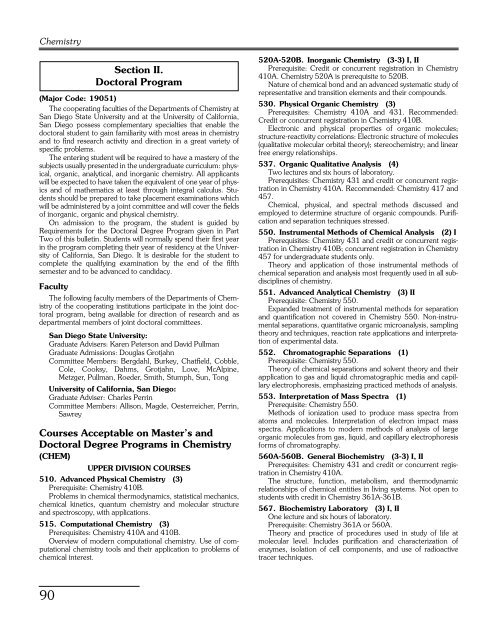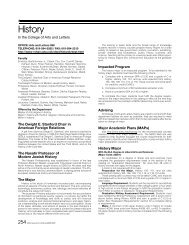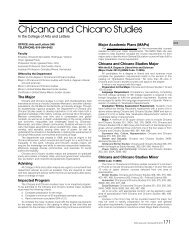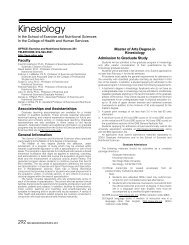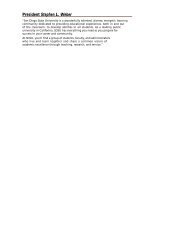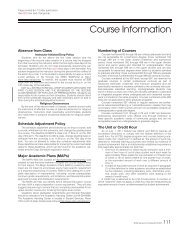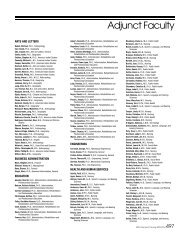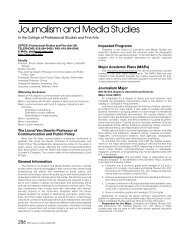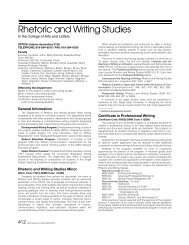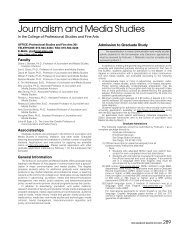President Stephen L. Weber - San Diego State University ...
President Stephen L. Weber - San Diego State University ...
President Stephen L. Weber - San Diego State University ...
You also want an ePaper? Increase the reach of your titles
YUMPU automatically turns print PDFs into web optimized ePapers that Google loves.
Chemistry<br />
Section II.<br />
Doctoral Program<br />
(Major Code: 19051)<br />
The cooperating faculties of the Departments of Chemistry at<br />
<strong>San</strong> <strong>Diego</strong> <strong>State</strong> <strong>University</strong> and at the <strong>University</strong> of California,<br />
<strong>San</strong> <strong>Diego</strong> possess complementary specialties that enable the<br />
doctoral student to gain familiarity with most areas in chemistry<br />
and to find research activity and direction in a great variety of<br />
specific problems.<br />
The entering student will be required to have a mastery of the<br />
subjects usually presented in the undergraduate curriculum: physical,<br />
organic, analytical, and inorganic chemistry. All applicants<br />
will be expected to have taken the equivalent of one year of physics<br />
and of mathematics at least through integral calculus. Students<br />
should be prepared to take placement examinations which<br />
will be administered by a joint committee and will cover the fields<br />
of inorganic, organic and physical chemistry.<br />
On admission to the program, the student is guided by<br />
Requirements for the Doctoral Degree Program given in Part<br />
Two of this bulletin. Students will normally spend their first year<br />
in the program completing their year of residency at the <strong>University</strong><br />
of California, <strong>San</strong> <strong>Diego</strong>. It is desirable for the student to<br />
complete the qualifying examination by the end of the fifth<br />
semester and to be advanced to candidacy.<br />
Faculty<br />
The following faculty members of the Departments of Chemistry<br />
of the cooperating institutions participate in the joint doctoral<br />
program, being available for direction of research and as<br />
departmental members of joint doctoral committees.<br />
<strong>San</strong> <strong>Diego</strong> <strong>State</strong> <strong>University</strong>:<br />
Graduate Advisers: Karen Peterson and David Pullman<br />
Graduate Admissions: Douglas Grotjahn<br />
Committee Members: Bergdahl, Burkey, Chatfield, Cobble,<br />
Cole, Cooksy, Dahms, Grotjahn, Love, McAlpine,<br />
Metzger, Pullman, Roeder, Smith, Stumph, Sun, Tong<br />
<strong>University</strong> of California, <strong>San</strong> <strong>Diego</strong>:<br />
Graduate Adviser: Charles Perrin<br />
Committee Members: Allison, Magde, Oesterreicher, Perrin,<br />
Sawrey<br />
Courses Acceptable on Master’s and<br />
Doctoral Degree Programs in Chemistry<br />
(CHEM)<br />
UPPER DIVISION COURSES<br />
510. Advanced Physical Chemistry (3)<br />
Prerequisite: Chemistry 410B.<br />
Problems in chemical thermodynamics, statistical mechanics,<br />
chemical kinetics, quantum chemistry and molecular structure<br />
and spectroscopy, with applications.<br />
515. Computational Chemistry (3)<br />
Prerequisites: Chemistry 410A and 410B.<br />
Overview of modern computational chemistry. Use of computational<br />
chemistry tools and their application to problems of<br />
chemical interest.<br />
90<br />
520A-520B. Inorganic Chemistry (3-3) I, II<br />
Prerequisite: Credit or concurrent registration in Chemistry<br />
410A. Chemistry 520A is prerequisite to 520B.<br />
Nature of chemical bond and an advanced systematic study of<br />
representative and transition elements and their compounds.<br />
530. Physical Organic Chemistry (3)<br />
Prerequisites: Chemistry 410A and 431. Recommended:<br />
Credit or concurrent registration in Chemistry 410B.<br />
Electronic and physical properties of organic molecules;<br />
structure-reactivity correlations: Electronic structure of molecules<br />
(qualitative molecular orbital theory); stereochemistry; and linear<br />
free energy relationships.<br />
537. Organic Qualitative Analysis (4)<br />
Two lectures and six hours of laboratory.<br />
Prerequisites: Chemistry 431 and credit or concurrent registration<br />
in Chemistry 410A. Recommended: Chemistry 417 and<br />
457.<br />
Chemical, physical, and spectral methods discussed and<br />
employed to determine structure of organic compounds. Purification<br />
and separation techniques stressed.<br />
550. Instrumental Methods of Chemical Analysis (2) I<br />
Prerequisites: Chemistry 431 and credit or concurrent registration<br />
in Chemistry 410B; concurrent registration in Chemistry<br />
457 for undergraduate students only.<br />
Theory and application of those instrumental methods of<br />
chemical separation and analysis most frequently used in all subdisciplines<br />
of chemistry.<br />
551. Advanced Analytical Chemistry (3) II<br />
Prerequisite: Chemistry 550.<br />
Expanded treatment of instrumental methods for separation<br />
and quantification not covered in Chemistry 550. Non-instrumental<br />
separations, quantitative organic microanalysis, sampling<br />
theory and techniques, reaction rate applications and interpretation<br />
of experimental data.<br />
552. Chromatographic Separations (1)<br />
Prerequisite: Chemistry 550.<br />
Theory of chemical separations and solvent theory and their<br />
application to gas and liquid chromatographic media and capillary<br />
electrophoresis, emphasizing practiced methods of analysis.<br />
553. Interpretation of Mass Spectra (1)<br />
Prerequisite: Chemistry 550.<br />
Methods of ionization used to produce mass spectra from<br />
atoms and molecules. Interpretation of electron impact mass<br />
spectra. Applications to modern methods of analysis of large<br />
organic molecules from gas, liquid, and capillary electrophoresis<br />
forms of chromatography.<br />
560A-560B. General Biochemistry (3-3) I, II<br />
Prerequisites: Chemistry 431 and credit or concurrent registration<br />
in Chemistry 410A.<br />
The structure, function, metabolism, and thermodynamic<br />
relationships of chemical entities in living systems. Not open to<br />
students with credit in Chemistry 361A-361B.<br />
567. Biochemistry Laboratory (3) I, II<br />
One lecture and six hours of laboratory.<br />
Prerequisite: Chemistry 361A or 560A.<br />
Theory and practice of procedures used in study of life at<br />
molecular level. Includes purification and characterization of<br />
enzymes, isolation of cell components, and use of radioactive<br />
tracer techniques.


